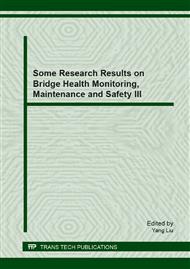[1]
Susendar Muthukumar, A contact element approach with hysteresis damping for the analysis and design of pounding in bridges, Georgia Institute of Technology, 2003.
Google Scholar
[2]
Susendar Muthukumar,Reginald DesRoches, A Hertz contact model with non-linear damping for pounding simulation. Earthquake Engng Struct. Dyn., 35, 811-828, 2006.
DOI: 10.1002/eqe.557
Google Scholar
[3]
Li Zhongxian, Yue Fuqing, Zhou LI, Equivalent kelvin impact model for pounding analysis of bridge during earthquake, Engineering Mechanics, 25(4), 128~133, 2008. (in Chinese)
Google Scholar
[4]
Li Zhongxian, Yue Fuqing, State of arts study on seismic pounding responses of urban bridges, Earthquake engineering and engineering vibration, 25(4), 91-97, 2005. (in Chinese)
Google Scholar
[5]
Stavros A. Anagnostopoulos, Equivalent viscous damping for modeling inelastic impacts in earthquake pounding problems. Earthquake Engng Struct. Dyn., 33, 897-902, 2004.
DOI: 10.1002/eqe.377
Google Scholar
[6]
Robert Jankowski, Non-linear viscoelastic modelling of earthquake-induced structural pounding. Earthquake Engng Struct. Dyn., 34, 595~611, 2005.
DOI: 10.1002/eqe.434
Google Scholar
[7]
Jaime Vega, Ignacio del Rey, Enrique Alarcon. Pounding force assessment in performance-based design of bridges. Earthquake Engineering and Structural Dynamics, 38, 1525-1544, 2009,.
DOI: 10.1002/eqe.916
Google Scholar
[8]
Robert Jankowski, Krzysztof Wilde, Yozo Fujino, Pounding of superstructure segments in isolated elevated bridge during earthquakes, Earthquake Engineering and Structural Dynamics, 27, 487-502, 1998.
DOI: 10.1002/(sici)1096-9845(199805)27:5<487::aid-eqe738>3.0.co;2-m
Google Scholar
[9]
Sang-Hoon Kim, Masanobu Shinozuka, Effects of seismically induced pounding at expansion joints of concrete bridges, Journal of Engineering Mechanics, 129, 1225~1234, 2003.
DOI: 10.1061/(asce)0733-9399(2003)129:11(1225)
Google Scholar
[10]
Giovanna Zanardo, Hong Hao, Claudio Modena, Seismic response of multi-span simply supported bridges to a spatially varying earthquake ground motion, Earthquake Engineering and Structural Dynamics, 31, 1325-1345, 2002.
DOI: 10.1002/eqe.166
Google Scholar
[11]
Chouw N., Hao H, Study of SSI and non-uniform ground motion effect on pounding between bridge girders, Soil Dynamics and Earthquake Engineering, 25, 717-728, 2005.
DOI: 10.1016/j.soildyn.2004.11.015
Google Scholar
[12]
Nawawi Chouw, Significance of soil-structure interaction and near-source earthquakes in causing pounding of bridge girders, Structures — Building on the Past: Securing the Future Proceedings of Structures Congress 2004, Structural Engineering, 2004.
DOI: 10.1061/40700(2004)141
Google Scholar
[13]
Anxin Guo, Zhongjun Li, Hui Li, et al, Experimental and analytical study on pounding reduction of base-isolated highway bridges using MR dampers, Earthquake Engng Struct. Dyn., 38, 1307-1333, 2009.
DOI: 10.1002/eqe.903
Google Scholar
[14]
A.X. Guo, Zh.J. Lia, H. Lia, Semi-active control of highway bridges with pounding effect by using magneto rheological dampers under earthquake excitations, International Conference on Smart Materials and Nanotechnology in Engineering, 2007.
DOI: 10.1117/12.779374
Google Scholar
[15]
Robert Jankowski, Krzysztof Wilde, Yozo Fujino, Reduction of pounding effects in elevated bridges during earthquakes, Earthquake engineering and Structural Dynamics, 29, 195-212, 2000.
DOI: 10.1002/(sici)1096-9845(200002)29:2<195::aid-eqe897>3.0.co;2-3
Google Scholar
[16]
Robert Jankowski, Krzysztof Wilde, Yozo Fujino, Pounding of superstructural segments in isolated elevated bridge during earthquakes, Earthquake engineering and Structural Dynamics, 27, 487-502, 1998.
DOI: 10.1002/(sici)1096-9845(199805)27:5<487::aid-eqe738>3.0.co;2-m
Google Scholar
[17]
Masanobu Shinozuka, Maria Q. Feng, Jae-Min Kim, et al, Mitigation of seismic pounding effect on bridges using dynamic restrainers. Newport Beach, 3989, 377-387, 2000.
DOI: 10.1117/12.384579
Google Scholar


